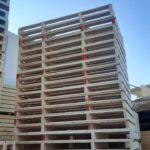What are skids?
Skids are relevant packing equipment in various packaging and logistics. They are flat structures designed to facilitate the movement, storage, and transportation of goods. Essentially, skids represent the earlier form of pallets, serving as a foundational concept for developing modern pallet systems. Skids lack the bottom deck boards that are characteristic of pallets. This absence makes skids less stable in comparison to pallets, especially in scenarios involving repetitive loading and unloading. The key components of skids typically include a flat top surface and supporting blocks or runner’s underneath. These runners allow forklifts, pallet jacks, or conveyors to lift and move the skid, facilitating the efficient handling of goods within a warehouse or during transportation.
While skids are suitable for certain applications, they may not possess the strength, durability, and stability required for long-term warehouse use, particularly in frequent loading and unloading situations. The primary purpose of skids is to enhance efficiency in the supply chain by ensuring the safe and organized movement of products. Skids find primary uses across diverse sectors, demonstrating their versatility and utility. These skids, often made of wood or other materials, serve as a foundation for packaging, storing, and transporting products. In this comprehensive guide, we will delve into the uses and advantages of skids while also helping you find reliable sources for skids for sale near you.
Key characteristics of skids
A prominent feature of storage skids is their flat and level deck. This characteristic serves as a fundamental base for stacking products, providing a stable foundation upon which goods can rest. Engineered with specific load capacities in mind, skids are designed to accommodate various product weights and dimensions. These skids come in different load-bearing classes, ensuring suitability for diverse storage needs.
Skids are seamlessly compatible with common material handling equipment such as forklifts, pallet jacks, and conveyor systems. Their standardized dimensions facilitate smooth interaction, streamlining the loading, unloading, and movement of goods within the warehouse. Another notable characteristic of skids is their stackability. This feature allows for the efficient utilization of vertical storage space in warehouses and distribution centres, contributing to the optimization of overall storage capacity.
How do skids help in storage applications in various fields?
In industrial applications, skids are integral to manufacturing processes, functioning as crucial components in material handling within manufacturing facilities. Serving as a stable base, skids facilitate the movement of raw materials and components during assembly and production processes. Moreover, they are employed as racks or shelving units to optimize floor space while storing products and materials in an organized manner.
Skids play an important role in palletizing goods, providing a stable foundation for loads in warehouses and distribution centres. This foundational support makes it simple to stack, store, and transport goods efficiently. Skids also contribute to the streamlined process of order picking, enabling workers to access items at varying heights using forklifts or pallet jacks.
In transportation and logistics, skids are indispensable in shipping and freight operations. They play a crucial role in containerized shipping by securing cargo within containers and preventing shifting during transit. Additionally, goods placed on skids are easier to load onto trucks and unload at distribution centres, reducing handling time and minimizing the risk of damage. In air cargo logistics, skids are utilized to standardize cargo loads, ensuring compatibility with aircraft cargo holds and simplifying the loading and unloading process at airports. Skids for sale near you will be helpful for direct checking and the purchase of skids according to your convenience.
On construction sites, skids contribute to efficient material handling and storage. They are used to transport heavy construction materials, including steel beams, concrete blocks, and pipes. Furthermore, skids serve a dual purpose by acting as temporary platforms and providing support for heavy machinery or equipment on uneven terrain. This adaptability makes skids an invaluable asset in the dynamic and multifaceted environments of construction sites.
Finding skids for sale near you:
If you’re in search of skids for sale near you, it’s essential to explore local suppliers who can meet your specific requirements. Here are some tips to help you find the right source: Start by searching for local suppliers or manufacturers of skids. Local businesses often provide personalized services and can cater to your immediate needs. Utilize online platforms and directories to find skid suppliers near you.
Many businesses list their products online, allowing you to compare prices and specifications easily. Connect with other businesses in your industry to gather recommendations. Networking can lead you to reliable suppliers who have a proven track record of providing quality skids. Attend trade shows or industry events where you can meet suppliers face-to-face. This provides an excellent opportunity to assess the quality of the skids and negotiate terms directly.
Choose the best-quality skids near you for all your packaging needs.
Skids are indispensable tools for businesses involved in material handling and transportation. Their versatility, cost-effectiveness, and space optimization make them an integral part of supply chain management. When seeking skids for sale near you, consider local suppliers, online platforms, networking, and trade shows to find the right fit for your business needs. By understanding the advantages of skids and making informed choices in their procurement, you can enhance the efficiency of your logistics operations.


